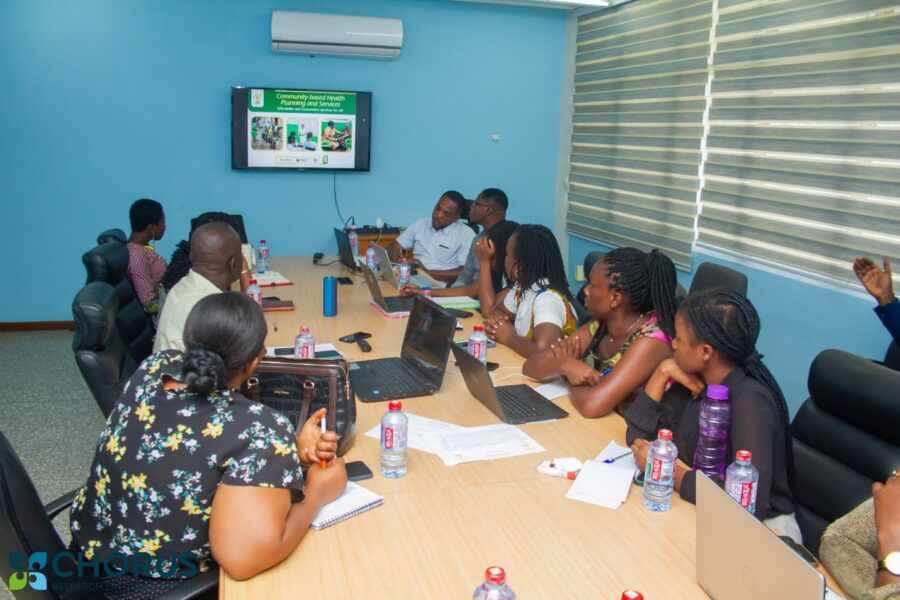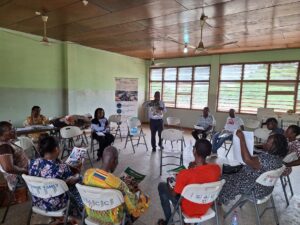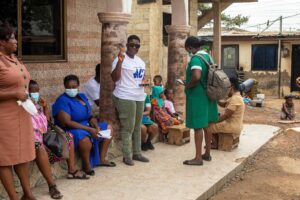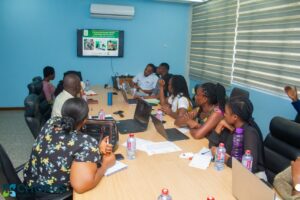
Co-producing Health Awareness Materials with the Health Promotion Division of the Ghana Health Service – Experiences, Lessons and Challenges
By Delali Kumapley (CHORUS Research Uptake Co-lead) and Selase Odopey (CHORUS Ghana Project Coordinator/Qualitative Researcher)
In the four years that the Community-led Responsive and Effective Urban Health Systems (CHORUS) Project has been running in Ghana, it has involved stakeholders including the residents of La Nkwantanang Madina and Ashaiman Municipalities (intervention sites), the Municipal Health Directors in these two communities, the Ministry of Health and the Ghana Health Service among others using a Participatory Research Approach (PAR). This research strategy emphasizes the involvement of participants in identifying a problem and working together to solve it, following a process of sequential reflection and action. The reflections and the opinions of all of these stakeholders have contributed to Ghana’s intervention which is being implemented in Ashaiman and La-Nkwantanang Madina Municipalities in the Greater Accra Region.
The overall objective of CHORUS Ghana is to co-produce with stakeholders and implement and evaluate a package of interventions that enable sustainable provision of life cycle health promotion and prevention programs and services at the household and community level for urban poor populations in Ghana.
The intervention covers three broad areas:
- Increasing awareness of promotive and preventive (including wellness) services of Community-based Health and Planning Services (CHPS).
- Increasing coverage of Primary Health Care services by extending home visits to businesses, marketplaces, worship centres etc.
- Empowering Community Health Officers to deliver life-cycle health promotion and preventive services (NCDs: diabetes, hypertension; mental health; and reproductive health) in urban poor areas.
The first component of CHORUS Ghana’s intervention – awareness creation of promotive and preventive services offered by CHPS – has had the team working directly with Ghana Health Service’s (GHS) Health Promotion Division (HPD). This was, among other reasons, to ensure the uptake of the materials by the Service after the project’s life span. The process also involved the representatives of the community, the health workers, and local government to form a Community Advisory Group as part of the Participatory Action Research approach.
The HPD is a technical division within the (GHS) with a mandate to contribute to the overall improvement of the population’s health status by implementing evidence-based health promotion interventions. The division’s mission is to enhance behaviour change and the adoption of positive lifestyles among the population through the provision of appropriate health information; and advocacy for an environment enabling individuals, families and communities to translate the information into desired action.
In February 2024, CHORUS Ghana placed a request to the Division materials that could be used to create awareness of the promotive and preventive services offered by CHPS in the urban setting. This initial meeting set the tone for subsequent engagements that led to the development of a jingle (English and translated into two local languages) and a poster. This blog details the engagement process, the challenges faced and the lessons that the Project has learnt during the process
First Physical Meeting with the HPD
An initial virtual call was had with the HPD/GHS where the team introduced CHORUS’ activities. This was followed by a physical meeting that was chaired by the Deputy Director of the Division – Bridget Anim- who, in a statement, acknowledged CHORUS Ghana’s work and assured the team that they were in line with the aims of HPD/GHS since both groups did not want to leave anyone behind in Primary Health Care provision.
Social and Behaviour Change Communication (SBCC) in health promotion is the systematic application of interactive, theory-based, and research-driven communication processes and strategies to address tipping points for change at the individual, community, and social levels.1 The three strategies of SBCC in health promotion include Behaviour Change Communication (BCC), Social Mobilization, and Advocacy. The various strategies are interconnected and can be employed in addressing health problems.
CHORUS Ghana researchers in a meeting at the Health Promotion Division, Ghana Health Service, Accra-Ghana.
Creating Health Promotion Materials
In that meeting, the overall objective for developing the materials, the target audience, their knowledge gap, and the misery we were addressing (what we were offering) were tabulated, and a rough draft jingle was produced.
Report on the brainstorming session
The jingle was a trialogue that creatively listed the services offered by CHPS in the urban setting. A draft poster with Artificially Intelligent–generated images was used as place-holders for the ‘dip-stick’ test. The consumer dipstick is the method by which materials are tested, especially during their formative stages and modified before launching, using qualitative methods like focus group discussions.2 These images were generated from the CHORUS team’s reflections and needs assessments findings about the extended CHPS.
Sample AI generated poster
Pretesting the Materials in the two intervention sites
The draft poster and the script for the jingle were then printed and pretested using the consumer dipstick method in the two intervention sites to determine (1) the level of clarity of the content of the materials; (2) its suitability and; (3) to assess the intended audience’s perceptions of its cultural relevance and appropriateness. The consumer dipstick was also to determine whether there are aspects of the materials that may be offensive and whether the language/visuals were appropriate and easily understood as well as solicit suggestions for improvement of the materials.
Pretesting Posters at Ashaiman Municipality
A total of four FGDs, with each discussion comprising of a maximum of 12 respondents, were held to solicit the views of the residents in the two intervention communities. These residents were purposively sampled and they included health workers, the aged, pregnant women, nursing mothers, youth and adolescents. The FGDs were led by the personnel from the HPD/GHS and the CHORUS team members served as coordinators/observers and were also present to take notes.
The content of the materials was assessed based on its technicality, language, layout, aesthetics/attractiveness, reader friendliness, clarity/comprehensibility, offensiveness/sensitivity, relevance/usefulness, impact/effectiveness.
Overall, the respondents were able to identify the activities being conducted by the health workers, found them attractive and also did not find anything offensive in what the poster presented. Through the FGD, it became evident that the community members were able to identify the health workers by the colour of their uniforms, which was brown/green. They also advised that the males on the prototype poster should wear appropriate gear to be identified as nurses.
The scripts of the jingles were also read and acted out by the groups in English and other selected local languages. The moderator then asked how they understood the script. Most of them were able to recall what they had heard from the script. The participants were then asked the most appropriate languages to record the jingles to receive maximum impact and these were suggested to the HPD/GHS and CHORUS Ghana teams. The comments received during the FGDs were incorporated into the design of the poster
The draft posters were also presented to the Community Advisory Groups (CAGs) at the two intervention sites and their views were also sought. CAGs are a voluntary group of members of the community where the research is being conducted that advises researchers on the experiences, needs, and expectations of the affected community.
Research Participants Serving As Models for the Posters
Following the FGDs and the meetings with the CAGs to conduct the consumer dip-stick, the research team and the HPD/GHS revised the posters and the jingles using the views of the groups that were met.
Since CHORUS is using a community-led and participatory research approach, the team approached the members of the intervention communities to serve as models for the posters that will be displayed in the community. The aim is to ensure that posters would attract community members to view, own and be aware of the existence of CHPS and the services they offer. The possibility of using the community members and health workers who worked in these sites was discussed with the HPD/GHS who advised the CHORUS team to be explicit in what will be required from these models in the consent forms. The community members and the health workers were excited to serve as models for these posters after the team clearly stated what the posters were going to be used for. The consent forms were designed and shared with the community members a week before the photos were taken. Parents and guardians of school children below 18 years provided a written consent for their children or wards to participate in the photo-taking. The CHORUS Ghana team and the GHS/HPD used two days to shoot these photographs of the models in their natural environments while receiving a service from the CHOs.
Preparing to take photos of the participants/models in the Ashaiman Municipality
The photos of the models were then used for the various posters in place of the photo holders. Each intervention site had a unique set of photos used for their posters. In all, four different posters were designed – two for each intervention site. After another round of consultations with the research team, the HPD/GHS were able to finalise the posters and the jingle was recorded in three languages – English, Twi and Hausa.
Final Meeting with the Technical Review Committee
On November 7th, the CHORUS Ghana team met with the Technical Review Committee of the HPD/GHS to evaluate the final outputs. The two outputs were then approved and endorsed by the HPD/GHS. The Technical Review Committee consisted of staff of the HPD/GHS from other departments. The posters and the jingle were reviewed from the perspective of team members who had not been part of the initial process to critique the materials. Their inputs were incorporated into the final output before the two outputs were finalized, approved and endorsed by the Division.
CHORUS Ghana researchers in a final review meeting at the Health Promotion Division Ghana Health Service, Accra-Ghana.
Challenges
Coproducing knowledge with practitioners, particularly in the government sector is time-consuming because of the bureaucratic nature of the communication. The process of co-producing these awareness creation materials with the HPD/GHS began in February 2024 but was finally approved in November 2024. This caused significant changes to the project’s timelines.
Lessons Learnt
1. Coproduction between researchers and practitioners is possible.
2. Evidence-based outputs facilitate the co-production process. In our case, our needs assessment had the evidence needed to support the material creation thus, during the first physical meeting and after a few hours of brainstorming, the first draft of the script for the jingle was produced. If the CHORUS team did not have findings to support the need for awareness creation materials, the process would have taken a much longer time or impeded the process.
References
1. John, G., & Bassey, E. N. (2020). Advocacy as a core strategy of social and behaviour change communication interventions. International Journal of Advanced Mass Communication and Journalism, 1(2), 21-26. 1
2. Social and Behaviour Change Communication Designing holistic and data-driven Communications to enable change – https://www.sbcguidance.org/understand/social-and-behaviour-change-communication
3. Dipstick Surveys or Ethnographic Market Research2 https://www.mavericksmr.com/
Photo Credit: CHORUS Team, University of Ghana





